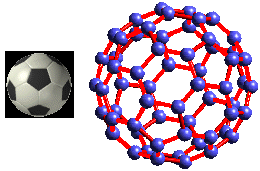Little bits of trouble
Extremely tiny particles known as buckyballs can harm living cells.
If you’ve kicked around a soccer ball, you may have noticed the pattern on the ball’s surface. The ball is stitched together from 12 patches with five sides (pentagons) and 20 patches with six sides (hexagons).
 |
|
|
About 20 years ago, chemists discovered that carbon can form into molecules with the same shape. They nicknamed them buckyballs. These strong, hollow particles may someday be used to carry medicine or even block the action of certain viruses.
Scientists have now found that buckyballs can harm living cells. Research by Eva Oberdörster, a biologist at Southern Methodist University in Dallas, and her team shows that these molecules damage brain cells in fish.
 |
|
A buckyball molecule (right) made up of 60 carbon atoms (blue spheres) has the same geometry as a soccer ball (left).
|
| U.S. Department of Energy |
Buckyballs belong to a group of materials known as nanomaterials. The prefix “nano” means one-billionth. A nanometer is one-billionth of a meter—roughly the width of just five carbon atoms lined up in a row. So, a buckyball is an extremely tiny particle—only a few ten-thousandths of the width of a human hair.
To make a nanomaterial, scientists manipulate individual atoms to build molecules of different shapes. Groups of these molecules form materials with particular characteristics, making them suitable for different jobs. For example, some nanomaterials are already being used in makeup and sunscreens.
Because buckyballs may someday be used in industry, Oberdörster and her team conducted experiments to find out if the molecules are toxic.
The researchers added different quantities of buckyballs to water in a fish tank. After 48 hours, they removed the fish from the tank and checked different parts of the fishes’ bodies for damage. Although none of them died, the exposed fish showed 17 times as much damage to brain cells as did fish not exposed to buckyballs.
In a separate experiment, Vicki Colvin of Rice University in Houston found that buckyballs damage human cells growing in a lab. But she also found a possible solution to the problem. Coating buckyballs with other kinds of simple molecules appears to make buckyballs safer.
Nanomaterial particles come in all sorts of sizes and shapes, so it’s not yet known whether they all have the same harmful effects that buckyballs do. It’s going to take a lot more experiments to sort out all the possible health effects of these amazing, new materials.—S. McDonagh
Going Deeper:
Goho, Alexandra. 2004. Tiny trouble: Nanoscale materials damage fish brains. Science News 165(April 3):211. Available at http://www.sciencenews.org/articles/20040403/fob1.asp .
Learn more about buckyballs by following the links at mathforum.org/alejandre/workshops/buckyball.html (Math Forum).
You can find images of some nanomaterials at www.zyvex.com/nanotech/visuals.html (Zyvex).
Instructions for building a buckyball are available at www.seed.slb.com/en/scictr/lab/buckyball/index.htm (Schlumberger).







